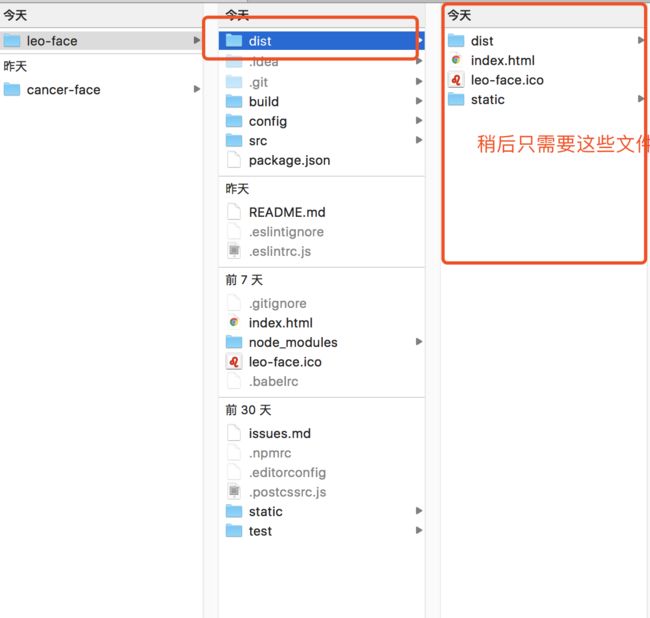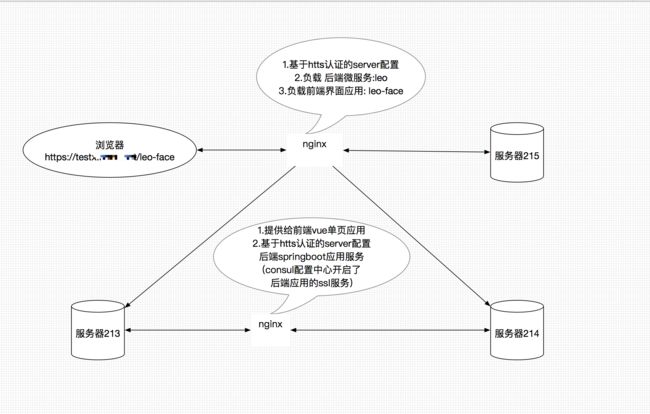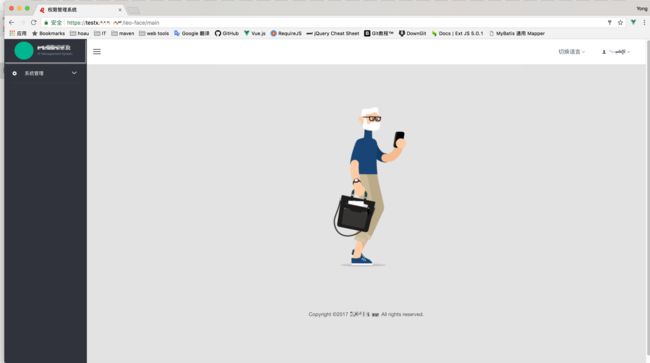前言
公司新项目是使用springboot作为后端的微服务,前端就让我自己捣鼓用现在比较火的vue来做的分离前端,边学边做折腾了一个月,项目也差不多了完成了一个功能,准备发布下测试环境了,但是问题来了.服务器上的后端服务是接入了cas中央认证服务的单点登录的(cas接单页应用真的很费劲啊,有时间就写下来).所以是基于https的,所以和同事商量,那就使用nginx大法搭建一个全站https吧
vue2项目中的配置
- 在webpack配置里主要还是
config/index.js的assetsPublicPath的设置
//config/index.js
module.exports = {
build: {
testEnv: require('./test.env'),
prodEnv: require('./prod.env'),
index: path.resolve(__dirname, '../dist/index.html'),
assetsRoot: path.resolve(__dirname, '../dist'),
assetsSubDirectory: 'static',
assetsPublicPath: '/leo-face/', //配置的是nginx下根目录新建的一个leo-face文件夹
productionSourceMap: true,
// Gzip off by default as many popular static hosts such as
// Surge or Netlify already gzip all static assets for you.
// Before setting to `true`, make sure to:
// npm install --save-dev compression-webpack-plugin
productionGzip: false,
productionGzipExtensions: ['js', 'css'],
// Run the build command with an extra argument to
// View the bundle analyzer report after build finishes:
// `npm run build --report`
// Set to `true` or `false` to always turn it on or off
bundleAnalyzerReport: process.env.npm_config_report
},
dev: {
env: require('./dev.env'),
port: 8089,
autoOpenBrowser: true,
assetsSubDirectory: 'static',
assetsPublicPath: '/',
proxyTable: {},
// CSS Sourcemaps off by default because relative paths are "buggy"
// with this option, according to the CSS-Loader README
// (https://github.com/webpack/css-loader#sourcemaps)
// In our experience, they generally work as expected,
// just be aware of this issue when enabling this option.
cssSourceMap: false
}
}
注意: 项目是用vue-cli脚手架搭建的,就有这个
config目录
- 构建的配置路径弄好了.就要执行相应的命令了
npm run build:test
- 附上
packagejson中script的命令
"build:test": "cross-env NODE_ENV=testing npm_config_preview=true npm_config_report=true node build/build.js",
- vue-cli生成的模板是没有这个命令的,这是我自己自定义的命令.首先会找到
build/build.js读取相应配置,读取的还是webpack.prod.conf.js这个配置,但是我在这个webpack profile中做了一些修改
// 调用方法,判断引入的后端接口地址
//这样一来,引入的就上面build.js对象中的testEnv的配置了
var env = process.env.NODE_ENV === 'testing'
? config.build.testEnv
: config.build.prodEnv
//plugins的HtmlWebpackPlugin修改
new HtmlWebpackPlugin({
filename: process.env.NODE_ENV === 'testing'
? 'index.html'
: config.build.index,
template: 'index.html',
favicon: resolveApp('leo-face.ico'),
inject: true,
minify: {
removeComments: true,
collapseWhitespace: true,
removeRedundantAttributes: true,
useShortDoctype: true,
removeEmptyAttributes: true,
removeStyleLinkTypeAttributes: true,
keepClosingSlash: true,
minifyJS: true,
minifyCSS: true,
minifyURLs: true
},
path: config.build.assetsPublicPath + config.build.assetsSubDirectory,
// necessary to consistently work with multiple chunks via CommonsChunkPlugin
chunksSortMode: 'dependency'
}),
//下面是test.env.js的配置
var merge = require('webpack-merge')
var devEnv = require('./dev.env')
module.exports = merge(devEnv, {
NODE_ENV: '"testing"',
BASE_API: '"https://testx.xxx.net/leo"', //整个应用后端请求的地址
})
- 打包环境配置好了,包也打好了生成的目录就是这样的,下图
- 现在还不能直接去折腾nginx,因为还有个重要的设置没有更改,如果你的项目中使用的vue-router,想部署上服务器有优雅的路径,那么现在就需要设置你的router对象属性了
//创建路由
export default new Router({
mode:'history',
base: '/leo-face/',
routes: constantRouterMap
});
参数我就不说明了,百度,官方一堆介绍
- 好了下面可以去折腾一下nginx了,由于我在本地已经搭建过nginx,也没有问题,所以就直接上服务器折腾.
Nginx 相关配置
- 服务器是linux的,和mac的差别不大.但是因为我是用homebrew装的nginx,只是目录有点不一样而已,附上自己三脚猫的画图功夫的流程图.
https域名入口服务器的nginx.conf配置,这台服务器是215
- linux上的
nginx/config目录nginx.conf配置
//后端服务负载策略
upstream leo {
server xxx.xxx.xxx.213:8424 weight=1;
server xxx.xxx.xxx.214:8424 weight=1;
}
//前端负载策略
upstream leo-face {
server xxx.xxx.xxx.213:443 weight=1;
server xxx.xxx.xxx.214:443 weight=1;
}
//server配置
server {
listen 443;
server_name testx.xxx.net;
ssl on;
ssl_certificate "name.pem"
ssl_certificate_key "name.key";
ssl_session_cache shared:SSL:10m;
ssl_session_timeout 10m;
ssl_protocols TLSv1 TLSv1.1 TLSv1.2;
ssl_ciphers HIGH:!RC4:!MD5:!aNULL:!eNULL:!NULL:!DH:!EDH:!EXP:+MEDIUM;
ssl_prefer_server_ciphers on;
location ~ /leo-face {
access_log logs/leo-faceacc.log main;
error_log logs/leo-face.log warn;
proxy_pass https://leo-face;
proxy_redirect off;
proxy_set_header Host $host:443;
proxy_set_header X-Real-IP $remote_addr;
proxy_set_header X-Forwarded-For $proxy_add_x_forwarded_for;
proxy_connect_timeout 180;
proxy_send_timeout 180;
proxy_read_timeout 180;
proxy_buffer_size 128k;
proxy_buffers 4 128k;
proxy_busy_buffers_size 128k;
proxy_temp_file_write_size 128k;
add_header Nginx-Cache "$upstream_cache_status";
}
location ~ /leo {
access_log logs/leoacc.log main;
error_log logs/leo.log warn;
proxy_pass https://leo;
proxy_redirect off;
proxy_set_header Host $host:443;
proxy_set_header X-Real-IP $remote_addr;
proxy_set_header X-Forwarded-For $proxy_add_x_forwarded_for;
proxy_connect_timeout 180;
proxy_send_timeout 180;
proxy_read_timeout 180;
proxy_buffer_size 128k;
proxy_buffers 4 128k;
proxy_busy_buffers_size 128k;
proxy_temp_file_write_size 128k;
add_header Nginx-Cache "$upstream_cache_status";
}
}
重启nginx服务器访问测试nginx的https是否开启
转发服务器nginx.conf的配置
server {
listen 443;
server_name xxx.xxx.xxx.213;
location /leo-face {
try_files $uri $uri/ /leo-face/index.html;
root /opt/nginx/html;
index index.html index.htm;
}
ssl on;
ssl_certificate "name.pem"
ssl_certificate_key "name.key";
ssl_session_cache shared:SSL:10m;
ssl_session_timeout 10m;
ssl_protocols TLSv1 TLSv1.1 TLSv1.2;
ssl_ciphers HIGH:!RC4:!MD5:!aNULL:!eNULL:!NULL:!DH:!EDH:!EXP:+MEDIUM;
ssl_prefer_server_ciphers on;
error_page 500 502 503 504 /50x.html;
location = /50x.html {
root html;
}
}
相关说明:
- 213 服务器的证书可以从入口服务器215上面拷贝一份过来,保持一致,ssl配置也可以拷贝
try_files $uri $uri/ /leo-face/index.html;由于页面是由js内部进行加载的,匹配当前url的所有地址,没有页面重定向到index.html. 官方说明- 有人觉得我后台服务为什么没有配置ssl? 上图已经声明了,后端springboot微服务使用的是consul这个分布式服务发现和共享配置的解决方案,在应用启动时读取了consul配置中心开启的springboot应用内置tomcat容器的ssl配置..并且证书放在应用包中.
发布
- 配置全部都完成了,接下来就是关键的点了.发布你的前端应用,记得前面打包好的文件了吧.
- 在nginx负载转发出去的应用服务器上(文章中是213,214俩台服务器)的
nginx/html目录下新建一个leo-face目录.把文件拷贝进去. - 现在你的访问目录就应该像这样
https://test.xxx.net/leo-face - 启动nginx或者重启nginx,
nginx -s reload
- 在nginx负载转发出去的应用服务器上(文章中是213,214俩台服务器)的
- 新建文件夹的名称是因为之前打包时webpack中配置了
assetsPublicPath的路径就是这个名字,所以在index.html引入的js,css地址前缀也会带这个名称
- 好了,现在访问一下看看,OK~ 完美...
会遇到的问题
- nginx入口服务器 配置相同域名多个访问路径时.是有匹配规则的,比如我把leo-face放在leo下就不能访问到/leo-face这个地址了
- 如按照文章中的顺序无法接入成功,则 先可以配置基于http单点应用服务器的nginx是否可以正常访问前端应用.后面再将https入口服务接入负载转发到应用服务器上


